Cisco Systems: Developing a Robust Disaster Recovery Plan Report
VerifiedAdded on 2023/01/23
|7
|1648
|81
Report
AI Summary
This report provides a comprehensive analysis of a disaster recovery plan for Cisco Systems, Inc. It begins with an overview of the organization, its structure, and its market position. The report then delves into the importance of disaster recovery in the context of modern business, outlining the objectives of an IT network disaster plan, which include minimizing business disruption, ensuring data backup, and establishing a disaster monitoring system. The report proposes an alternative network architecture for disaster management and details the steps involved in developing a disaster recovery plan (DRP) policy, including creating and testing the plan, forming a disaster retrieval group, and prioritizing operations. It also discusses disaster declaration procedures and potential disaster scenarios, such as technological failures and cyberattacks, along with methods for dealing with these events. The report further outlines disaster recovery procedures, the roles and responsibilities of various teams (Board of Directors, Executive Directors, Administrative Team, Technical Team, Fund Development Authority, Human Resource Department, and Relief teams), and the methods and services provided by the Disaster Recovery Team. The report concludes by describing the authority and reporting procedures within the disaster recovery structure, emphasizing a top-down approach for quick response and resource allocation. The report is supported by various academic references.

Disaster Recovery
Student’s name
Institution Affiliation(s)
Student’s name
Institution Affiliation(s)
Paraphrase This Document
Need a fresh take? Get an instant paraphrase of this document with our AI Paraphraser
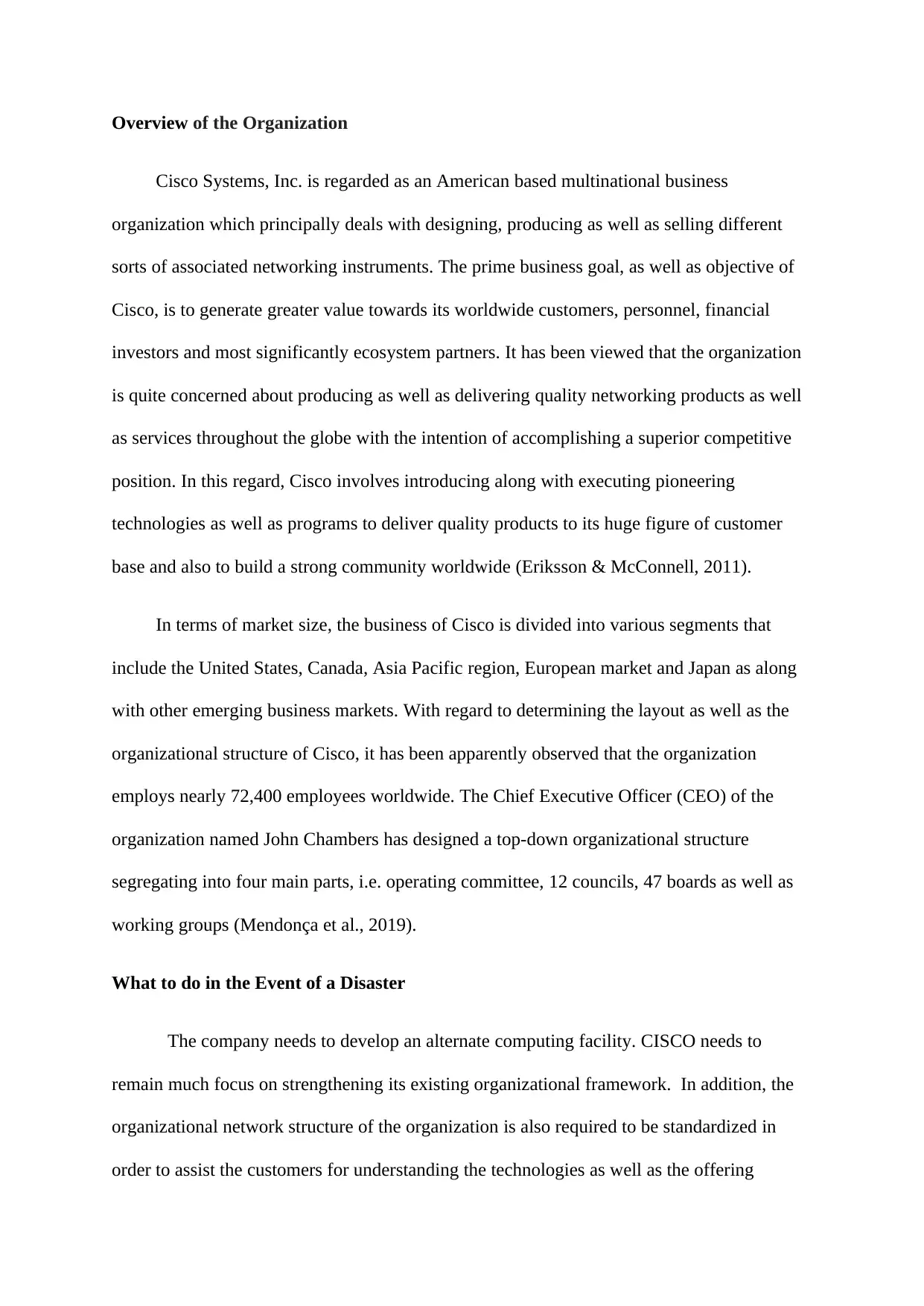
Overview of the Organization
Cisco Systems, Inc. is regarded as an American based multinational business
organization which principally deals with designing, producing as well as selling different
sorts of associated networking instruments. The prime business goal, as well as objective of
Cisco, is to generate greater value towards its worldwide customers, personnel, financial
investors and most significantly ecosystem partners. It has been viewed that the organization
is quite concerned about producing as well as delivering quality networking products as well
as services throughout the globe with the intention of accomplishing a superior competitive
position. In this regard, Cisco involves introducing along with executing pioneering
technologies as well as programs to deliver quality products to its huge figure of customer
base and also to build a strong community worldwide (Eriksson & McConnell, 2011).
In terms of market size, the business of Cisco is divided into various segments that
include the United States, Canada, Asia Pacific region, European market and Japan as along
with other emerging business markets. With regard to determining the layout as well as the
organizational structure of Cisco, it has been apparently observed that the organization
employs nearly 72,400 employees worldwide. The Chief Executive Officer (CEO) of the
organization named John Chambers has designed a top-down organizational structure
segregating into four main parts, i.e. operating committee, 12 councils, 47 boards as well as
working groups (Mendonça et al., 2019).
What to do in the Event of a Disaster
The company needs to develop an alternate computing facility. CISCO needs to
remain much focus on strengthening its existing organizational framework. In addition, the
organizational network structure of the organization is also required to be standardized in
order to assist the customers for understanding the technologies as well as the offering
Cisco Systems, Inc. is regarded as an American based multinational business
organization which principally deals with designing, producing as well as selling different
sorts of associated networking instruments. The prime business goal, as well as objective of
Cisco, is to generate greater value towards its worldwide customers, personnel, financial
investors and most significantly ecosystem partners. It has been viewed that the organization
is quite concerned about producing as well as delivering quality networking products as well
as services throughout the globe with the intention of accomplishing a superior competitive
position. In this regard, Cisco involves introducing along with executing pioneering
technologies as well as programs to deliver quality products to its huge figure of customer
base and also to build a strong community worldwide (Eriksson & McConnell, 2011).
In terms of market size, the business of Cisco is divided into various segments that
include the United States, Canada, Asia Pacific region, European market and Japan as along
with other emerging business markets. With regard to determining the layout as well as the
organizational structure of Cisco, it has been apparently observed that the organization
employs nearly 72,400 employees worldwide. The Chief Executive Officer (CEO) of the
organization named John Chambers has designed a top-down organizational structure
segregating into four main parts, i.e. operating committee, 12 councils, 47 boards as well as
working groups (Mendonça et al., 2019).
What to do in the Event of a Disaster
The company needs to develop an alternate computing facility. CISCO needs to
remain much focus on strengthening its existing organizational framework. In addition, the
organizational network structure of the organization is also required to be standardized in
order to assist the customers for understanding the technologies as well as the offering
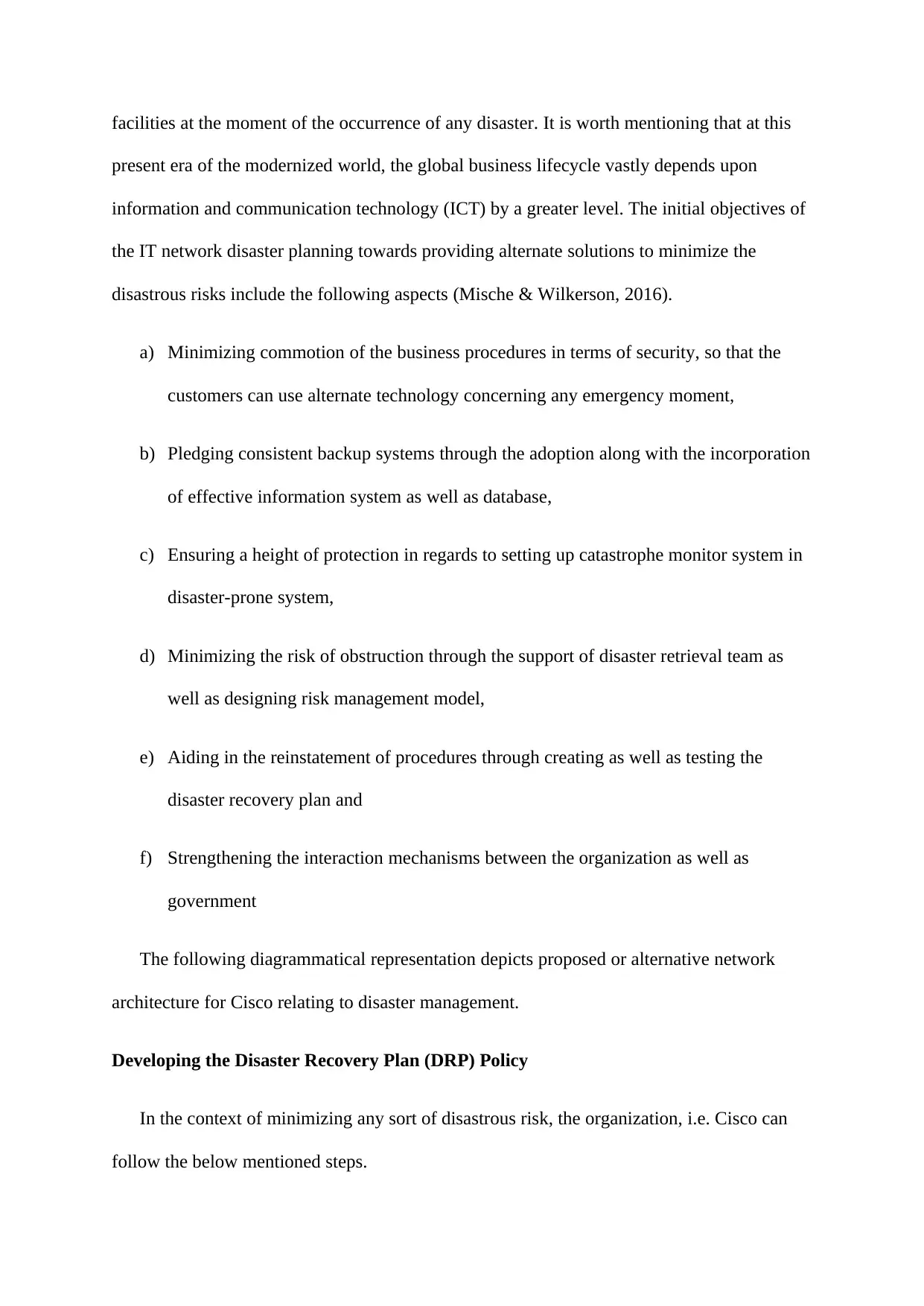
facilities at the moment of the occurrence of any disaster. It is worth mentioning that at this
present era of the modernized world, the global business lifecycle vastly depends upon
information and communication technology (ICT) by a greater level. The initial objectives of
the IT network disaster planning towards providing alternate solutions to minimize the
disastrous risks include the following aspects (Mische & Wilkerson, 2016).
a) Minimizing commotion of the business procedures in terms of security, so that the
customers can use alternate technology concerning any emergency moment,
b) Pledging consistent backup systems through the adoption along with the incorporation
of effective information system as well as database,
c) Ensuring a height of protection in regards to setting up catastrophe monitor system in
disaster-prone system,
d) Minimizing the risk of obstruction through the support of disaster retrieval team as
well as designing risk management model,
e) Aiding in the reinstatement of procedures through creating as well as testing the
disaster recovery plan and
f) Strengthening the interaction mechanisms between the organization as well as
government
The following diagrammatical representation depicts proposed or alternative network
architecture for Cisco relating to disaster management.
Developing the Disaster Recovery Plan (DRP) Policy
In the context of minimizing any sort of disastrous risk, the organization, i.e. Cisco can
follow the below mentioned steps.
present era of the modernized world, the global business lifecycle vastly depends upon
information and communication technology (ICT) by a greater level. The initial objectives of
the IT network disaster planning towards providing alternate solutions to minimize the
disastrous risks include the following aspects (Mische & Wilkerson, 2016).
a) Minimizing commotion of the business procedures in terms of security, so that the
customers can use alternate technology concerning any emergency moment,
b) Pledging consistent backup systems through the adoption along with the incorporation
of effective information system as well as database,
c) Ensuring a height of protection in regards to setting up catastrophe monitor system in
disaster-prone system,
d) Minimizing the risk of obstruction through the support of disaster retrieval team as
well as designing risk management model,
e) Aiding in the reinstatement of procedures through creating as well as testing the
disaster recovery plan and
f) Strengthening the interaction mechanisms between the organization as well as
government
The following diagrammatical representation depicts proposed or alternative network
architecture for Cisco relating to disaster management.
Developing the Disaster Recovery Plan (DRP) Policy
In the context of minimizing any sort of disastrous risk, the organization, i.e. Cisco can
follow the below mentioned steps.
⊘ This is a preview!⊘
Do you want full access?
Subscribe today to unlock all pages.

Trusted by 1+ million students worldwide
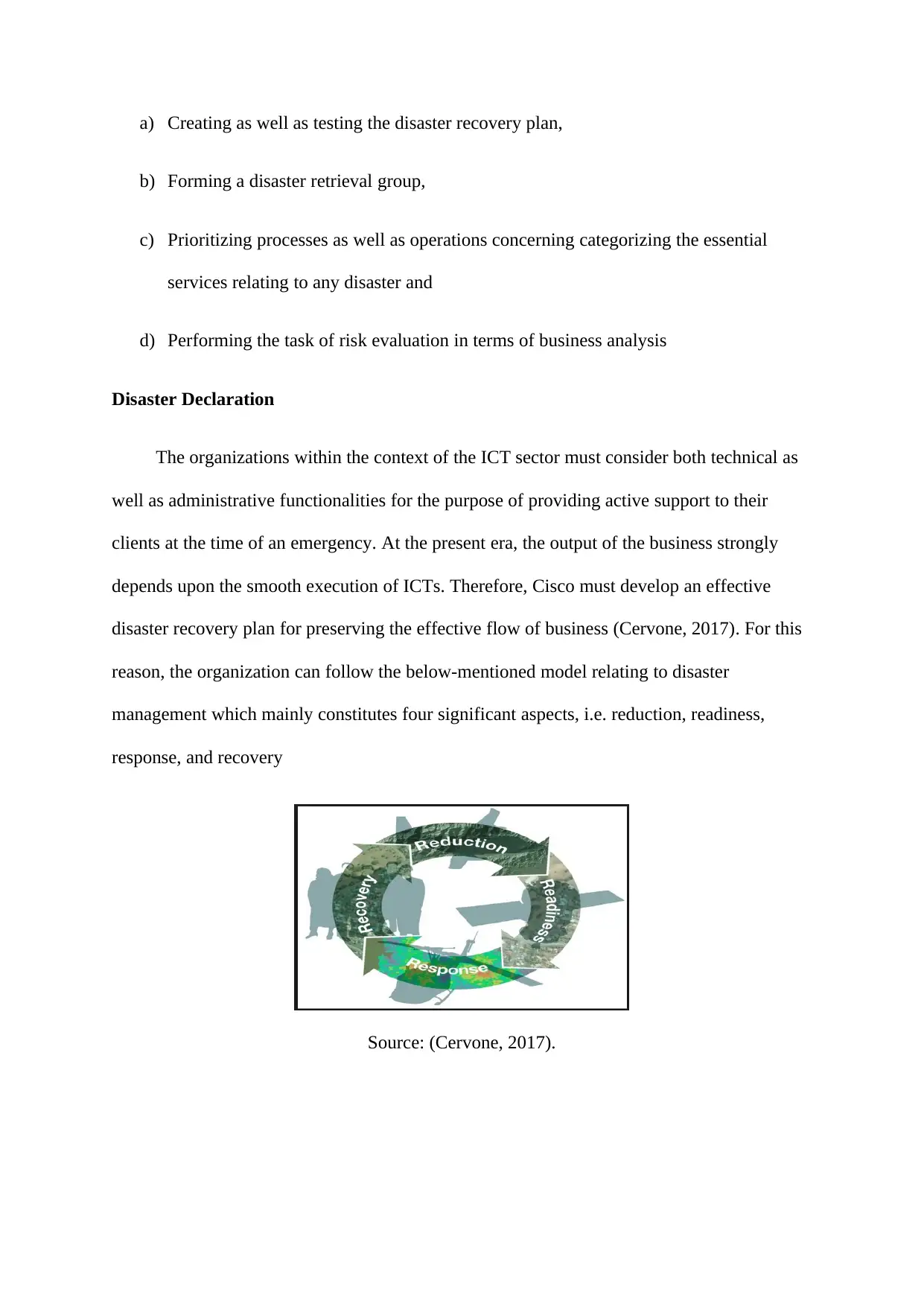
a) Creating as well as testing the disaster recovery plan,
b) Forming a disaster retrieval group,
c) Prioritizing processes as well as operations concerning categorizing the essential
services relating to any disaster and
d) Performing the task of risk evaluation in terms of business analysis
Disaster Declaration
The organizations within the context of the ICT sector must consider both technical as
well as administrative functionalities for the purpose of providing active support to their
clients at the time of an emergency. At the present era, the output of the business strongly
depends upon the smooth execution of ICTs. Therefore, Cisco must develop an effective
disaster recovery plan for preserving the effective flow of business (Cervone, 2017). For this
reason, the organization can follow the below-mentioned model relating to disaster
management which mainly constitutes four significant aspects, i.e. reduction, readiness,
response, and recovery
Source: (Cervone, 2017).
b) Forming a disaster retrieval group,
c) Prioritizing processes as well as operations concerning categorizing the essential
services relating to any disaster and
d) Performing the task of risk evaluation in terms of business analysis
Disaster Declaration
The organizations within the context of the ICT sector must consider both technical as
well as administrative functionalities for the purpose of providing active support to their
clients at the time of an emergency. At the present era, the output of the business strongly
depends upon the smooth execution of ICTs. Therefore, Cisco must develop an effective
disaster recovery plan for preserving the effective flow of business (Cervone, 2017). For this
reason, the organization can follow the below-mentioned model relating to disaster
management which mainly constitutes four significant aspects, i.e. reduction, readiness,
response, and recovery
Source: (Cervone, 2017).
Paraphrase This Document
Need a fresh take? Get an instant paraphrase of this document with our AI Paraphraser
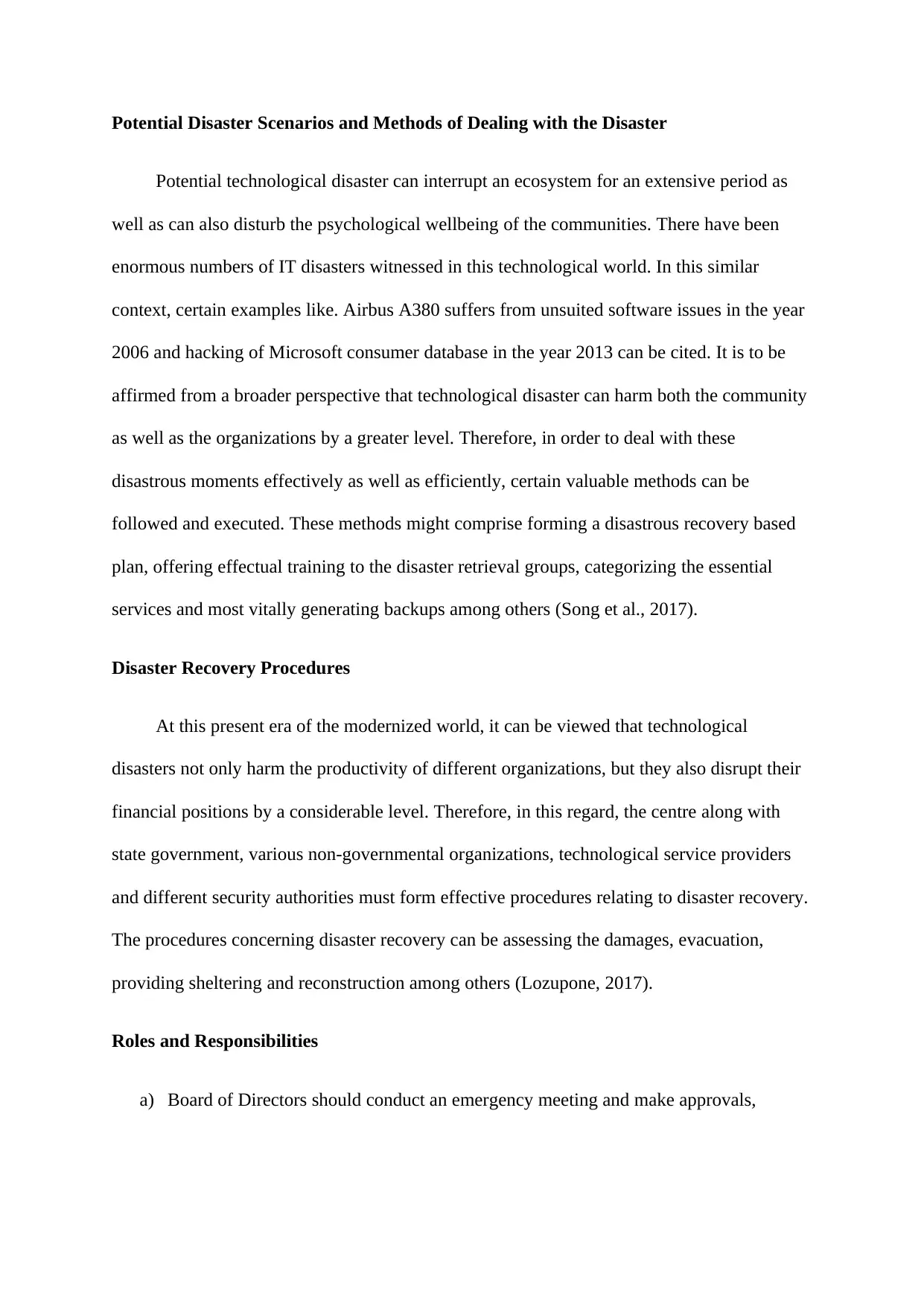
Potential Disaster Scenarios and Methods of Dealing with the Disaster
Potential technological disaster can interrupt an ecosystem for an extensive period as
well as can also disturb the psychological wellbeing of the communities. There have been
enormous numbers of IT disasters witnessed in this technological world. In this similar
context, certain examples like. Airbus A380 suffers from unsuited software issues in the year
2006 and hacking of Microsoft consumer database in the year 2013 can be cited. It is to be
affirmed from a broader perspective that technological disaster can harm both the community
as well as the organizations by a greater level. Therefore, in order to deal with these
disastrous moments effectively as well as efficiently, certain valuable methods can be
followed and executed. These methods might comprise forming a disastrous recovery based
plan, offering effectual training to the disaster retrieval groups, categorizing the essential
services and most vitally generating backups among others (Song et al., 2017).
Disaster Recovery Procedures
At this present era of the modernized world, it can be viewed that technological
disasters not only harm the productivity of different organizations, but they also disrupt their
financial positions by a considerable level. Therefore, in this regard, the centre along with
state government, various non-governmental organizations, technological service providers
and different security authorities must form effective procedures relating to disaster recovery.
The procedures concerning disaster recovery can be assessing the damages, evacuation,
providing sheltering and reconstruction among others (Lozupone, 2017).
Roles and Responsibilities
a) Board of Directors should conduct an emergency meeting and make approvals,
Potential technological disaster can interrupt an ecosystem for an extensive period as
well as can also disturb the psychological wellbeing of the communities. There have been
enormous numbers of IT disasters witnessed in this technological world. In this similar
context, certain examples like. Airbus A380 suffers from unsuited software issues in the year
2006 and hacking of Microsoft consumer database in the year 2013 can be cited. It is to be
affirmed from a broader perspective that technological disaster can harm both the community
as well as the organizations by a greater level. Therefore, in order to deal with these
disastrous moments effectively as well as efficiently, certain valuable methods can be
followed and executed. These methods might comprise forming a disastrous recovery based
plan, offering effectual training to the disaster retrieval groups, categorizing the essential
services and most vitally generating backups among others (Song et al., 2017).
Disaster Recovery Procedures
At this present era of the modernized world, it can be viewed that technological
disasters not only harm the productivity of different organizations, but they also disrupt their
financial positions by a considerable level. Therefore, in this regard, the centre along with
state government, various non-governmental organizations, technological service providers
and different security authorities must form effective procedures relating to disaster recovery.
The procedures concerning disaster recovery can be assessing the damages, evacuation,
providing sheltering and reconstruction among others (Lozupone, 2017).
Roles and Responsibilities
a) Board of Directors should conduct an emergency meeting and make approvals,
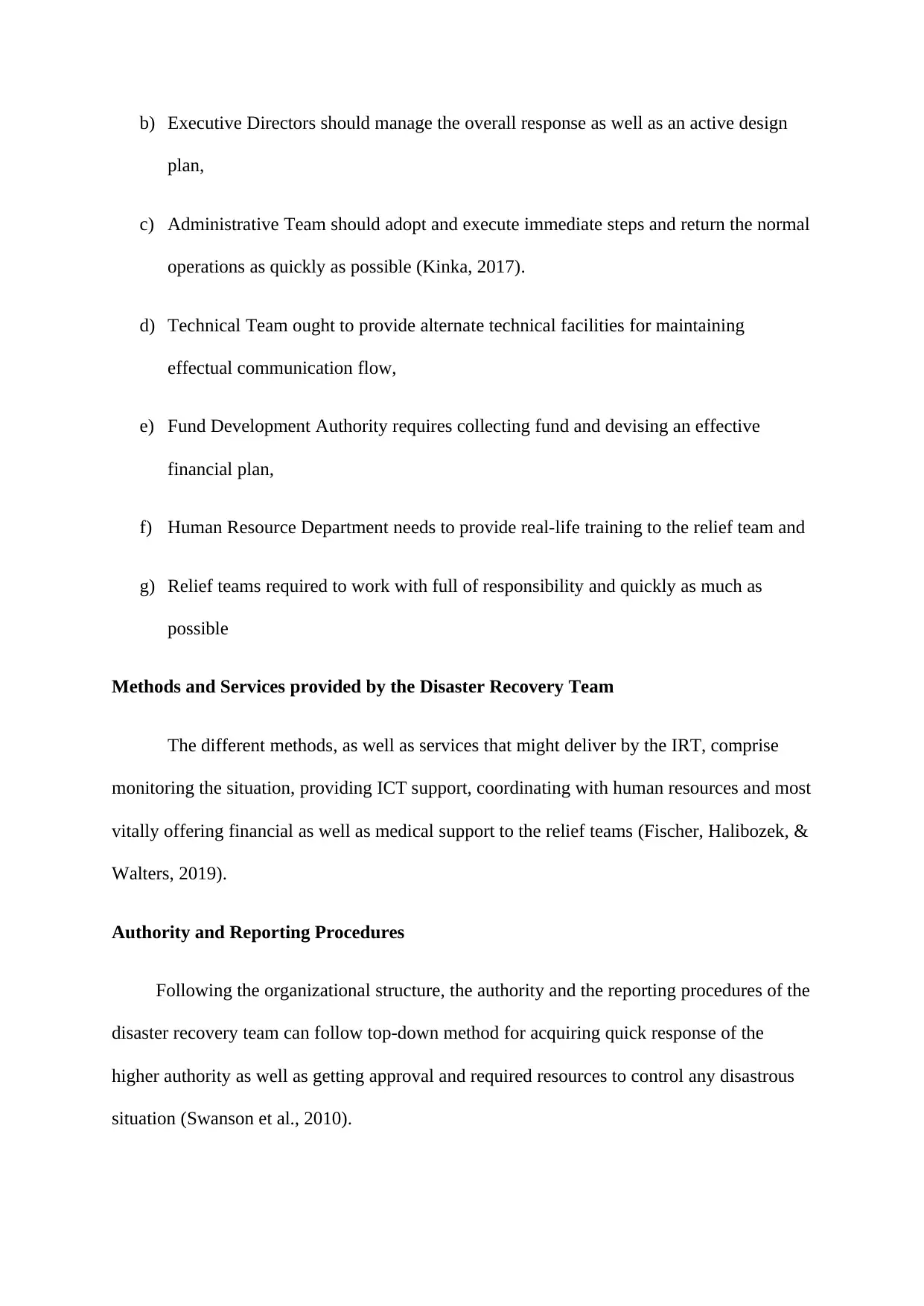
b) Executive Directors should manage the overall response as well as an active design
plan,
c) Administrative Team should adopt and execute immediate steps and return the normal
operations as quickly as possible (Kinka, 2017).
d) Technical Team ought to provide alternate technical facilities for maintaining
effectual communication flow,
e) Fund Development Authority requires collecting fund and devising an effective
financial plan,
f) Human Resource Department needs to provide real-life training to the relief team and
g) Relief teams required to work with full of responsibility and quickly as much as
possible
Methods and Services provided by the Disaster Recovery Team
The different methods, as well as services that might deliver by the IRT, comprise
monitoring the situation, providing ICT support, coordinating with human resources and most
vitally offering financial as well as medical support to the relief teams (Fischer, Halibozek, &
Walters, 2019).
Authority and Reporting Procedures
Following the organizational structure, the authority and the reporting procedures of the
disaster recovery team can follow top-down method for acquiring quick response of the
higher authority as well as getting approval and required resources to control any disastrous
situation (Swanson et al., 2010).
plan,
c) Administrative Team should adopt and execute immediate steps and return the normal
operations as quickly as possible (Kinka, 2017).
d) Technical Team ought to provide alternate technical facilities for maintaining
effectual communication flow,
e) Fund Development Authority requires collecting fund and devising an effective
financial plan,
f) Human Resource Department needs to provide real-life training to the relief team and
g) Relief teams required to work with full of responsibility and quickly as much as
possible
Methods and Services provided by the Disaster Recovery Team
The different methods, as well as services that might deliver by the IRT, comprise
monitoring the situation, providing ICT support, coordinating with human resources and most
vitally offering financial as well as medical support to the relief teams (Fischer, Halibozek, &
Walters, 2019).
Authority and Reporting Procedures
Following the organizational structure, the authority and the reporting procedures of the
disaster recovery team can follow top-down method for acquiring quick response of the
higher authority as well as getting approval and required resources to control any disastrous
situation (Swanson et al., 2010).
⊘ This is a preview!⊘
Do you want full access?
Subscribe today to unlock all pages.

Trusted by 1+ million students worldwide
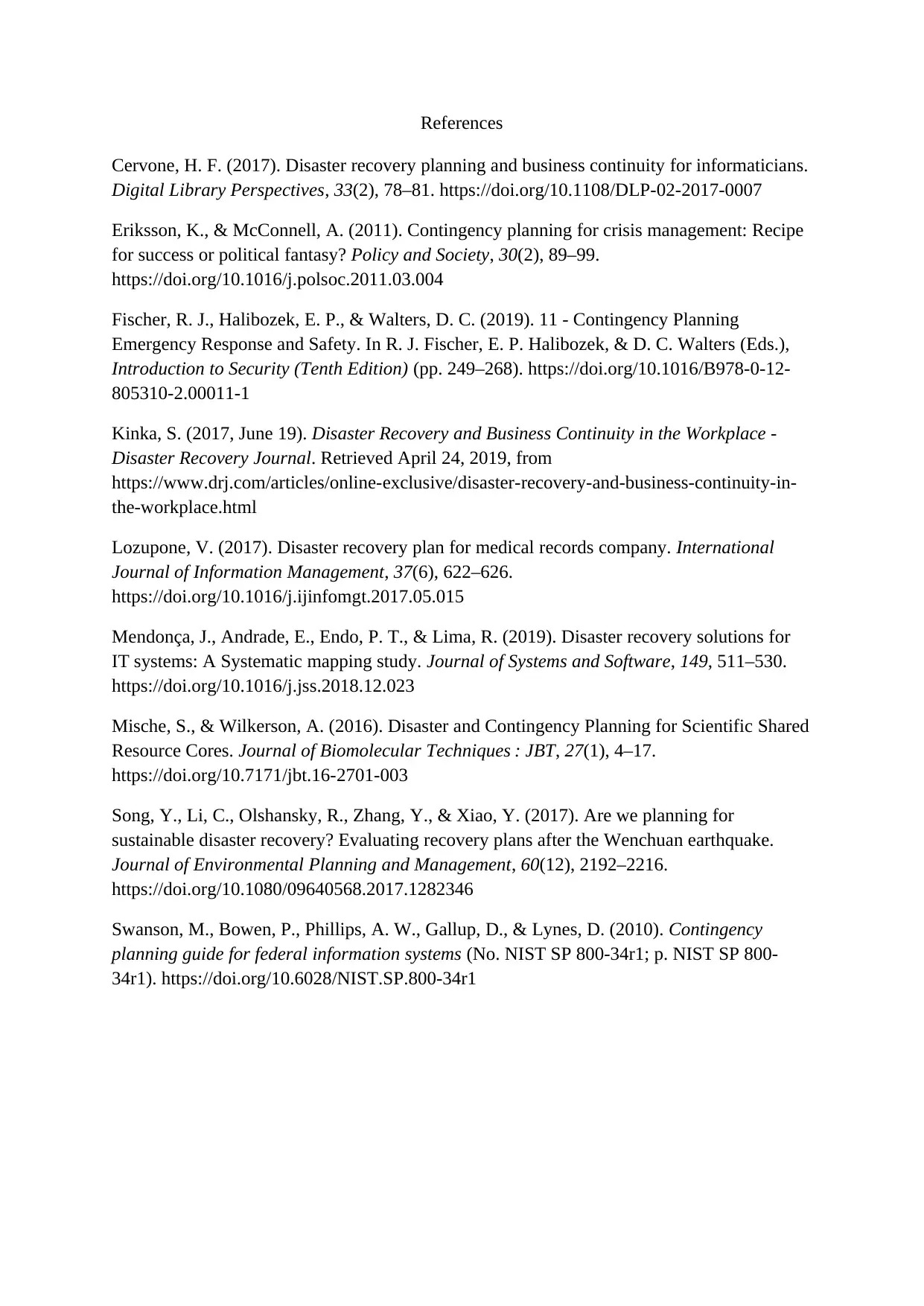
References
Cervone, H. F. (2017). Disaster recovery planning and business continuity for informaticians.
Digital Library Perspectives, 33(2), 78–81. https://doi.org/10.1108/DLP-02-2017-0007
Eriksson, K., & McConnell, A. (2011). Contingency planning for crisis management: Recipe
for success or political fantasy? Policy and Society, 30(2), 89–99.
https://doi.org/10.1016/j.polsoc.2011.03.004
Fischer, R. J., Halibozek, E. P., & Walters, D. C. (2019). 11 - Contingency Planning
Emergency Response and Safety. In R. J. Fischer, E. P. Halibozek, & D. C. Walters (Eds.),
Introduction to Security (Tenth Edition) (pp. 249–268). https://doi.org/10.1016/B978-0-12-
805310-2.00011-1
Kinka, S. (2017, June 19). Disaster Recovery and Business Continuity in the Workplace -
Disaster Recovery Journal. Retrieved April 24, 2019, from
https://www.drj.com/articles/online-exclusive/disaster-recovery-and-business-continuity-in-
the-workplace.html
Lozupone, V. (2017). Disaster recovery plan for medical records company. International
Journal of Information Management, 37(6), 622–626.
https://doi.org/10.1016/j.ijinfomgt.2017.05.015
Mendonça, J., Andrade, E., Endo, P. T., & Lima, R. (2019). Disaster recovery solutions for
IT systems: A Systematic mapping study. Journal of Systems and Software, 149, 511–530.
https://doi.org/10.1016/j.jss.2018.12.023
Mische, S., & Wilkerson, A. (2016). Disaster and Contingency Planning for Scientific Shared
Resource Cores. Journal of Biomolecular Techniques : JBT, 27(1), 4–17.
https://doi.org/10.7171/jbt.16-2701-003
Song, Y., Li, C., Olshansky, R., Zhang, Y., & Xiao, Y. (2017). Are we planning for
sustainable disaster recovery? Evaluating recovery plans after the Wenchuan earthquake.
Journal of Environmental Planning and Management, 60(12), 2192–2216.
https://doi.org/10.1080/09640568.2017.1282346
Swanson, M., Bowen, P., Phillips, A. W., Gallup, D., & Lynes, D. (2010). Contingency
planning guide for federal information systems (No. NIST SP 800-34r1; p. NIST SP 800-
34r1). https://doi.org/10.6028/NIST.SP.800-34r1
Cervone, H. F. (2017). Disaster recovery planning and business continuity for informaticians.
Digital Library Perspectives, 33(2), 78–81. https://doi.org/10.1108/DLP-02-2017-0007
Eriksson, K., & McConnell, A. (2011). Contingency planning for crisis management: Recipe
for success or political fantasy? Policy and Society, 30(2), 89–99.
https://doi.org/10.1016/j.polsoc.2011.03.004
Fischer, R. J., Halibozek, E. P., & Walters, D. C. (2019). 11 - Contingency Planning
Emergency Response and Safety. In R. J. Fischer, E. P. Halibozek, & D. C. Walters (Eds.),
Introduction to Security (Tenth Edition) (pp. 249–268). https://doi.org/10.1016/B978-0-12-
805310-2.00011-1
Kinka, S. (2017, June 19). Disaster Recovery and Business Continuity in the Workplace -
Disaster Recovery Journal. Retrieved April 24, 2019, from
https://www.drj.com/articles/online-exclusive/disaster-recovery-and-business-continuity-in-
the-workplace.html
Lozupone, V. (2017). Disaster recovery plan for medical records company. International
Journal of Information Management, 37(6), 622–626.
https://doi.org/10.1016/j.ijinfomgt.2017.05.015
Mendonça, J., Andrade, E., Endo, P. T., & Lima, R. (2019). Disaster recovery solutions for
IT systems: A Systematic mapping study. Journal of Systems and Software, 149, 511–530.
https://doi.org/10.1016/j.jss.2018.12.023
Mische, S., & Wilkerson, A. (2016). Disaster and Contingency Planning for Scientific Shared
Resource Cores. Journal of Biomolecular Techniques : JBT, 27(1), 4–17.
https://doi.org/10.7171/jbt.16-2701-003
Song, Y., Li, C., Olshansky, R., Zhang, Y., & Xiao, Y. (2017). Are we planning for
sustainable disaster recovery? Evaluating recovery plans after the Wenchuan earthquake.
Journal of Environmental Planning and Management, 60(12), 2192–2216.
https://doi.org/10.1080/09640568.2017.1282346
Swanson, M., Bowen, P., Phillips, A. W., Gallup, D., & Lynes, D. (2010). Contingency
planning guide for federal information systems (No. NIST SP 800-34r1; p. NIST SP 800-
34r1). https://doi.org/10.6028/NIST.SP.800-34r1
1 out of 7
Related Documents
Your All-in-One AI-Powered Toolkit for Academic Success.
+13062052269
info@desklib.com
Available 24*7 on WhatsApp / Email
![[object Object]](/_next/static/media/star-bottom.7253800d.svg)
Unlock your academic potential
Copyright © 2020–2025 A2Z Services. All Rights Reserved. Developed and managed by ZUCOL.





